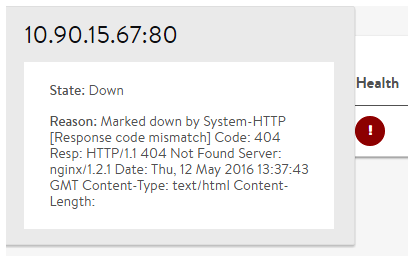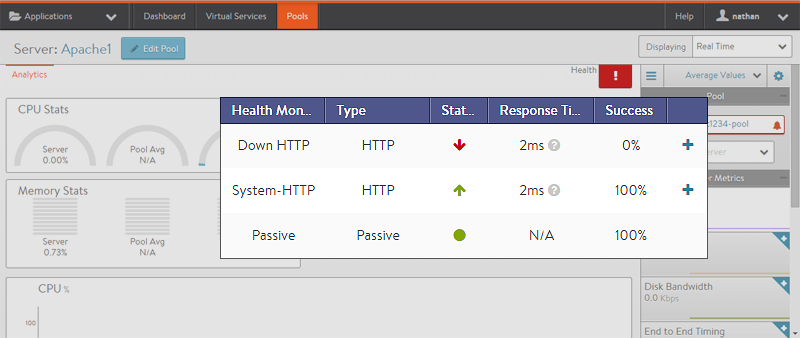Servers within a pool can have a status of up, down, or disabled (administratively disabled by an administrator). The status is determined by the associated health monitors applied to the server pool.
Avi Load Balancer can mark a server down for several reasons that can be accessed in three different ways. All methods show roughly the same information.
Down Health Score Icon: Hover the mouse over a server’s red status icon in the UI.

Down Event: Navigate to the events for the server, the pool, the virtual service. Expand the event to see full details. This information can be used to automatically generate an alert and potentially make further system changes. See the alerts overview for more info.
Server Page: Navigate to . This displays the analytics page for the server.

In this example, the Down-HTTP monitor is marking the server down, whereas the “System-HTTP” monitor is reporting the server as up.
The Passive monitor is a special type. A passive monitor will not mark a server down. Instead, if a passive monitor detects bad server-to-client responses, the monitor reduces the percentage of traffic load balanced to that server. Click the + sign next to the health monitor to show additional information regarding the server’s health status.
Common Reasons for Marking Down a Server
ARP Unresolved: The SE could not resolve the MAC address of the server’s IP address (when in the same layer two domain) or failed to initiate a TCP connection (when the server is a layer three hop away).
Payload Mismatch: The health monitor expects specific content to be returned in the response body (HTTP or TCP). In the example, an excerpt of the server’s response is shown. Often this type of error occurs when a server’s first response is to send a redirect to a client. The expected content appears in the client browser, but from Avi Load Balancers perspective, the client received a redirect.
Response Code Mismatch: HTTP health checks may be configured to expect a specific response code, such as 2xx. Meanwhile, the server may send back a different code, such as 404.
Response Timeout with a Threshold Violation: Health monitors wait a timeout period for a response, and every health monitor can be assigned its own threshold and timeout period. If a valid response is not received within the timeout period, for N consecutive times equal to the threshold, then the server is marked down.
While Avi Load Balancer is engineered for easy troubleshooting, there are times when more advanced tools may be required. At these times, it may be useful to capture a trace of the conversation between the SE and the server. (Navigate to . For more information, see Traffic Capture.)
Tools such as ping and curl can prove helpful when launched from a client machine to the server. However, these tools may not be reliable when executed by administrators from SEs. This is due to the dual network stacks used for the data plane and management.
For example, a tool such as a ping is executed from Linux using the SE management IP and network. The results can be different from than the SE is reporting when it is health checking through its data NICs and networks. For the ping example, use ping -l to verify the interface used.